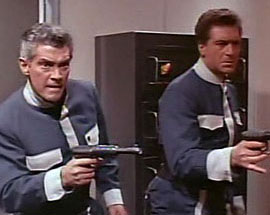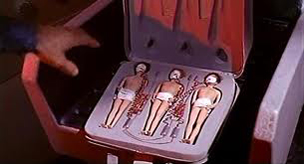
 |
|
|
|
The Wild, Wild Planet is the terrific English title for Antonio Margheriti's I criminali della galassia, a goofy Italian space opera and the first and best installment in what is sometimes called the "Gamma 1 Quadrilogy". 1 The movies are juvenile Buck Rogers-style adventures filmed on a low budget. This story features plenty of futuristic cities, rocket bases, big-finned spaceships and an orbiting space station called Gamma 1 -- all realized with sometimes laughably weak special effects. 
The eventful story is a "way out" spy saga that takes place in a mod future. Brawny space Commander Mike Halstead (Tony Russel) works for the United Democracies Space Command (UDSC), which is being subverted by the more progressive (and secretive) CBM Corporation. Halstead isn't sure he likes CBM scientist Mr. Nurmi (Massimo Serato), who is experimenting in miniaturizing human organs. Nurmi takes a shine to the 'perfect physical specimen' Lt. Connie Gomez (Lisa Gastoni), a communications and control officer who is also a martial arts instructor. Halstead is then called back to Earth to investigate the disappearance of dozens of VIPs. It turns out that CBM and Nurmi are engaged in a wild conspiracy to create a new breed of man. Dozens of artificial female spies fan out, accompanied by lookalike goons, also automatons, in black sunglasses. They miniaturize their victims, pack them in suitcases and transport them like dolls to a planetoid called Delphos, to be re-sized and physically altered. If a kidnap fails, the goons and spies can disintegrate themselves with a special brooch pin. More disappearances follow, and one important man interrupted in the shrinking process is turned into a midget. Defying orders, Halstead enlists the unofficial aid of his crack space crew to trace the conspiracy to its origin. Little does he know that Delphos is the ultimate mad lab, where Nurmi's men are fabricating secret agents on an assembly line and surgically altering people: a notable example is a man with four "fusion grafted" arms. Even worse, Nurmi has a bizarre plan to merge himself with Lt. Connie, thereby producing the "perfect human". The Wild, Wild Planet certainly moves along. Much of the action follows the sexy female spies and their expressionless henchman, who are presumably played by different men wearing identical masks. All of the dialogue is post-dubbed and most of the actors appear to be speaking English. The dialog is either functional or ludicrous. When Halsted urges somebody to speak, he says, "Blast away!" A typical insult is, "You helium-headed idiot, you!" Then there are limp stabs at sexy humor: "Watch out for those gadgets on their chests!" Amid all the strained futuristic dialogue, Commander Halstead receives a message in the form of a very ordinary telegram -- in an envelope that he has to rip open. 
A more witty script would have helped, and the production is barely adequate for a '60s TV show. The many elaborate interior sets look thrown together from found items and painted bright colors. A piece of Mr. Nurmi's equipment appears to be a console from a dentist's office. Settings on the space station and on Earth have identical curtains for walls. The lighting is mostly flat and uninteresting. The Proteo Theater entertains people with a butterfly dance (choreographed by our old friend Archie Savage) but the audience must stand because there are no seats. The staging implies that the audience area is dark, but in the one-setup-fits-all lighting plan, the ring of viewers is just as brightly lit as the dancers. I don't want to call the miniature effects terrible, and will stick with the word "ambitious". The sometimes-shaky spaceships in Japanese Sci-Fi films look far better. No opticals were possible but the Italians don't even try to film any of the effects in slow motion. The sketchy model cityscapes have no depth of field. We can see exactly how big things really are because a number of popular scale models are used as 'futuristic' craft -- a monorail car is a familiar helicopter made from a plastic kit. The orbiting space station has a bad wobble. The other spaceships seem built from metal and are crafted to hold gas jets to simulate rocket engines. All of the angles are similar, indicating a very restrictive rig for their shooting. The only full-scale space action is a brief spacewalk near the beginning, with hesitant spacemen swinging and spinning on very visible wires. 
The rest of the action takes place on interior sets or down on Earth on roadways with a couple of fairly cute bubble-topped cars. The Space Command's ray pistols have very noticeable crooked gun barrels. Nurmi shows Halsted a room full of mutant-like surgical failures, as we saw in the John Carradine horror pic The Unearthly. The finale on Delphos picks up a little, with an exciting flood of blood-like liquid and lot more karate fighting. Margheriti's tacky Sci-Fi films have been given a pass by post-70s genre critics, many of whom turn their noses up at juvenile American space adventures, yet praise almost any continental fantasy filmmaking as superior. The crazy plot machinations -- shrinking kidnappees a la Attack of the Puppet People -- are indeed amusing, but they come straight from low-grade spy spoofs, where the mad plans of evil geniuses often involve Sci-Fi experiments on a comic strip level. The Wild, Wild Planet is colorful but cardboard, and its diverting costumes and energetic performances don't make up for the stock characterizations. Yet every once and a while we'll see a weird touch that really works, such as the sight of a line of what look like incubators for newborn babies -- each with a little 'puppet person' lying inside. 
I don't see the Gamma 1 movies as exercises in camp satire. Everybody plays completely straight, and there are no signs of a tongue-in-cheek attitude. Your average Italo sword 'n' sandal movie has much more camp value. For the lack of a better theory, Daily Variety's 1967 review took the approach that The Wild, Wild Planet is a Hercules movie transplanted to outer space -- the athletes are still there, but they wear space garb. The film's dazzling poster art (pictured above) is much more dynamic than the movie itself. It would take Mario Bava to truly adapt the graphic possibilities of camp comic art to film in the deliriously beautiful Danger: Diabolik. After seeing a selection of Bava films, or even Riccardo Freda Pictures, Antonio Margheriti comes off as a third-rater. Fans somehow overlook the fact that Margheriti opens far too many scenes with fairly meaningless zooms. He doesn't go so far as to hose down his set with the zoom lens, as does The Great Pretender Jesús Franco, but it's a really ugly style. Pretty much all the players pitch their performances as if doing a 50s TV show, with Massimo Serato adding plenty of oily menace to his manner -- I wouldn't let him dance with my girlfriend, let alone take her off to a holiday on some unknown destination called Delphos. Tony Russel looks as if he could be James Darren's over-stressed older brother, with bushier eyebrows. Lisa Gastoni is attractive, but hardly anybody's idea of the perfect female specimen. Further down the cast list is future Lancelot Franco Nero, who is prettier than anybody but only gets to serve second-banana sidekick duty. 
Fans of the Gamma 1 films wasted no time ordering the Warner Archive Collection's DVD-R of The Wild, Wild Planet. The previous transfers I've seen all made the film look like it was made for TV. Warners' widescreen enhanced image restores a sense of composition to many scenes. Colors are vivid as well. Composer Angelo Francesco Lavagnino scored all four of the Gamma pix. His music is most noticeable in the Proteus Theater dance scenes, where the main theme sounds like an undeveloped rough draft melody for John Barry's Born Free. The English dubbing is quite good. The Wild, Wild Planet is exactly the right kind of picture for the Warner Archive Collection, a must-have title for collectors that probably couldn't sell enough copies to justify a full DVD release.
On a scale of Excellent, Good, Fair, and Poor,
The Wild, Wild Planet rates:
Footnote:
1. The Gamma 1 Trilogy: I Criminali Della Galassia (Wild, Wild Planet), I Diafanoidi Vengono Da Marte (War Of The Planets), Il Pianeta Errante (War Between The Planets), and La Morte Viene Dal Pianeta Aytin (Snow Devils). An unofficial fifth installment was produced in Japan: The Green Slime.
Reviews on the Savant main site have additional credits information and are often updated and annotated with reader input and graphics. Also, don't forget the 2010 Savant Wish List. T'was Ever Thus.
Review Staff | About DVD Talk | Newsletter Subscribe | Join DVD Talk Forum |
| ||||||||||||||||||